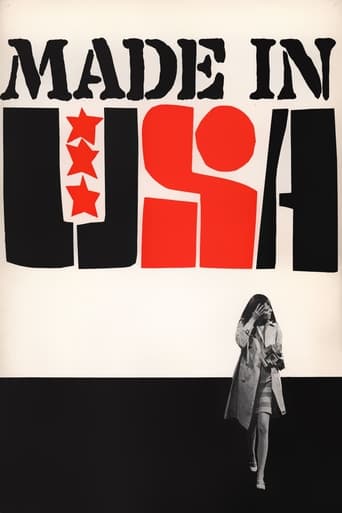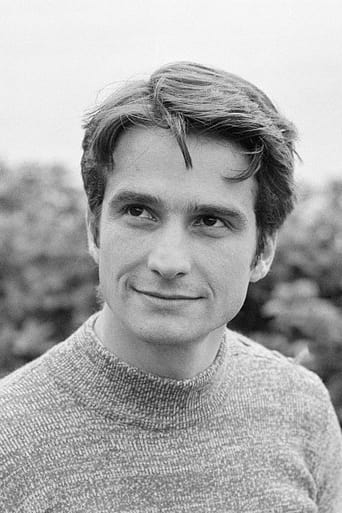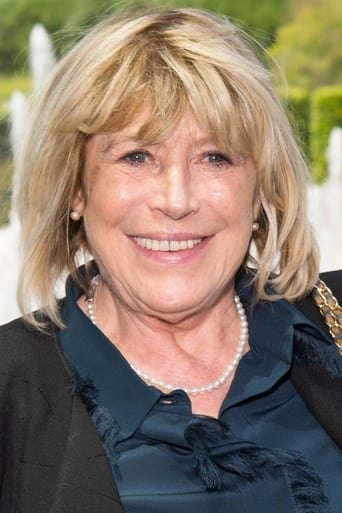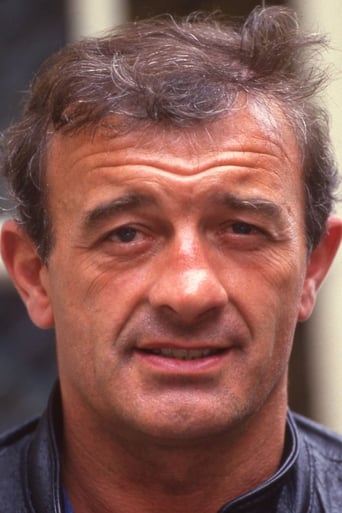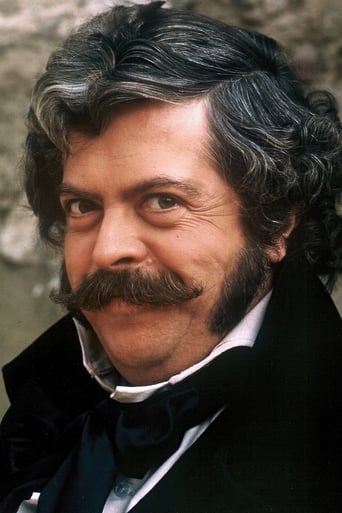jakob13
Dwight MacDonald might not have liked Goddard's 'Made in U.S.A.'It is a film that marries high culture and low, which bristles DM disdain for 'masscult'. For 2016 film goers 'Made in U.S.A.'is a 20 questions quiz. It has everything thrown in from soup to nuts, from pulp fiction to politics to literature to American politics to Hollywood and even to the signature of the 'last of the Red Hot Mamas' Miss Sophie Tucker. Goddard references Horace MaCoy's 'Kiss Tomorrow Goodbye', which rests on Anna Karina's breast in the opening shot, but substitutes it with the words of say Samuel Beckett. His characters have the names of Hollywood directors, Goddard admired. Selig or Misoguchi for example. Or writers like Ben Hecht. His bad guys bear the monikers of Nixon and Robert Macnamara. Into his script he doffs his hat to the poet Prevert or Louis Aragon or the writer Jean-Paul Sartre. Otto Preminger is a street name. Richard Widmark is in good company as a killer, and he delights in Karina killing the detective novels David Goodis. Who today recalls the abduction of the Moroccan leftist opponent of Hassan II, abducted at noon in St. Germain des Pres? Or Mers El Kebir or the failure of the Free French to wrest Dakar from Vichy control? Or the destruction of Agadir during a strong earth quake or the crushing to death of protesters when the police closed the Metro Charonne? And Goddard's disembodied voice rings out on an AIWA tape recorder as he condemns the sterile politics of the French Right and Left and the pusillanimous Communist Party, a condemnation which finds echos into America's presidential brouhaha for the White House. 'Made in U.S.A.' is full of talk that today might send the viewer to turn off his DVD player. Is it a museum piece? an obscure film that best be viewed by cinema students? Goddard's film is a relic of the turbulent 1960s, of a France exiting from a long war in Algeria in 1962, ending fighting wars from 1939 till June 1962. As the country under DeGaulle's Fifth Republic energized a tired France, the American war in Vietnam brought about what the French called the 'May Days of 1968', but we are ahead of the story the film tells. 'Made in U.S.A.' reflects through Goddard's lens the 'Sturm und Drum' of those seemingly forgotten Times.
jzappa
Godard's subversively titled twelfth feature is an constantly mystifying hodgepodge of film narration, images, and memorandums. Dedicated to Nick (Ray) and Samuel (Fuller), this ironically long-unavailable film in America is, technically anyway, a political noir about people acting like they're living in a movie. "You can fool the audience, but not me," Anna Karina, tells someone. This Criterion-salvaged piece, as can invariably be expected of its director, makes reference to its own forced artificiality as well as aware of that aspect of itself as the central object of notice for even the most accustomed viewer of avant-garde and experimental films: When characters talk, it's almost always to either contemplate the character of language or frankly observe the time passing.Neon signs and electronic news ribbons proliferate. So do comic strips and film stills. Most of the characters, like Donald Siegel and Doris Mizoguchi, are named for Godard's favorite movie figures, and allusions to American movie characters are everywhere, including three from three separate films by Otto Preminger, who also has a street named for him in the movie's make-believe Atlantic City. This stunningly self-conscious political diatribe's cinephilic gags and cartoon violence smack of Alphaville.In her final performance for Godard, Anna Karina is Paula Nelson, a P.I. swathed in an overcoat and packing heat. As The Big Sleep has an infamously indecipherable plot, one of whose many murders not even Hawks could clarify, so this is Godard's most unrelentingly unbalanced of plot convention. Crucial scenes, if you can call them that, are systematically minced right at the moment of revelation. Information in the dialogue is resolutely buried by street noise or two brash Beethoven chords, as, variantly seductive and apathetic, Paula goes looking for an ostensibly vanished lover, likely dead, in a tangled, tortuous, never elucidated international political conspiracy.Supposedly, Godard had much more than Raymond Chandler and Donald E. Westlake on one's mind. This patchwork mingles the Americanization of French life with the widespread controversy of mid-60s France, the vanishing of Morocco's foremost leftist, a political expatriate in France and a third-world personage then akin to Malcolm X or Che Guevara, kidnapped by French police acting in cahoots with the Moroccan government, which evidently had him tortured to death on French terrain. That he disappeared while traveling to a development meeting for a documentary, made the incident even more dramatic for Godard. Supposedly, this work of sociopolitical meta fiction is an imagining that he'd not died but had hidden in the provinces, wrote to his girlfriend to meet him. When she gets there, she discovers him dead.So the movie starts with Paula secluded in a shoddy hotel room in the characterless Paris suburb that doubles for Atlantic City, reflecting on her state of affairs while a couple of hooligans, played by New Wave regulars László Szabó and Jean-Pierre Léaud, linger portentously under her window. "Hanging out" is one of the movie's "active" (if that word could be used) factors. This awkward satire has characteristics of the sometimes fascinating, sometimes pedantic time-languishing revue that distinguished the art-house of the '60s. Early on, Marianne Faithful sits inexplicably in a neighborhood café, nonchalantly trilling As Tears Go By a cappella. But chiefly, Raoul Coutard's camera stares at the star, a statue. Frankly, you could forget all about the political and sociological vinegar and find the movie's really all about contemplating Karina's concealed grins, her dark hair, her switching clothes, and her eerie ability to turn any given shot into a fashion promo. Considering that we hear her voice-over all over, it's not unlike a Jarmusch-esque lone wolf enterprise.Plot, to use the term carelessly, accelerates when Paula slays the irritating midget stoolie Mr. Typhus: "Now fiction overtakes reality," she self-narrates. Storytelling is leaps and bounds more complicated and theoretically brutal here as in The Big Sleep or Kiss Me Deadly. Like Marlowe or Hammer, Paula finds a succession of corpses during her mission. She also leaves a footpath of others as her own upshot, including one whom she just shoots at close range. Later on, she serves the movie's most celebrated, and loaded, line: "We were in a political movie. Walt Disney with blood." Roughly when characters named Nixon and McNamara show up as hoodlums, played by young film critics, the reel-to-reel tape recorders that have been sporadically stationary in close-up to play messages left by Paula's lover change to egalitarian discourse.The movie is anti-capitalist and anti-consumerist, condemning miniskirts and rock and roll as manner of fascist brainwashing, but more invested in the kitschy modernism favored by the informal consensus within the mainstream of Western culture than any movie Godard made prior or since. Paula asserts that advertising is a form of fascism, representing the director. It's a legitimate grievance and an upsetting one, considering that Made in U.S.A. is a relentless commercial for itself. Perhaps the cleverest thing about it might be its title, which offers perspective on that element.Pending this work, Godard was a nationalist for some, a populist for others, but didn't folks assert the same thing about Orson Welles? And yet for others, he was just an armchair politico. Made in U.S.A. is an opinionated exploit that's equally as sincere as a formal expression of political will, a judgmental breakdown of pop culture and a cautionary lecture in which, this time, the filmmaker has become so explicitly caught up that he felt he had to film it himself.
LeRoyMarko
A cinematographic experiment by Jean-Luc Godard! Not too accessible. Interesting opening credits with just the initials of the cast. The colors are bright, contrasting with the usual black and white movies that Godard made before this one. At some point, the movie reminded me of the hit series "Twin Peaks" by David Lynch. But this is way more incoherent. In fact, it's hard to figure if there's anything to be made of this film. Still, Godard get to explore the fascination of the French for everything that comes from the U.S.A. Another interesting fact: some of the talks exchanged by the characters (ex. in the bar scene). A linguist would probably have some fun analyzing this. Some scenes are just painful to watch if you're tired (ex. the political manifesto on tape)! Anna Karina is great to watch, as usual.Out of 100, I give it 71. That's good for ** out of ****.Seen at home, in Toronto, on November 26th, 2002.
